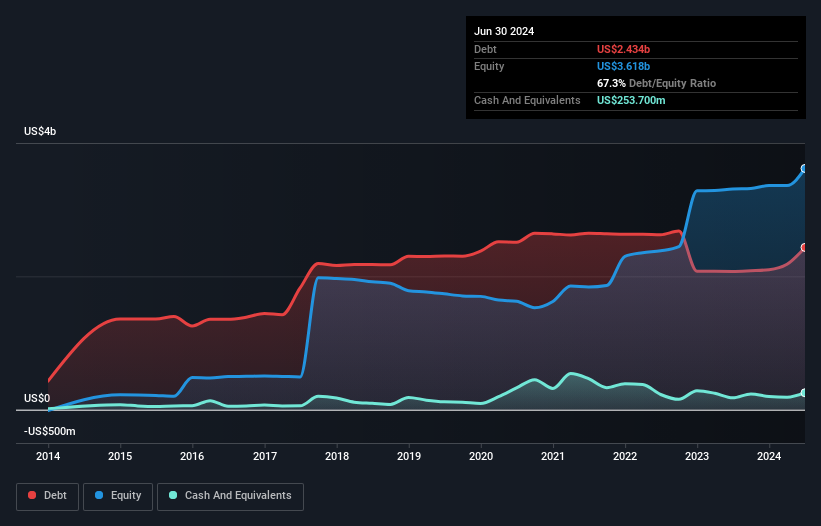- United States
- /
- Healthcare Services
- /
- NasdaqGS:SGRY
Surgery Partners (NASDAQ:SGRY) Takes On Some Risk With Its Use Of Debt
Howard Marks put it nicely when he said that, rather than worrying about share price volatility, 'The possibility of permanent loss is the risk I worry about... and every practical investor I know worries about.' So it seems the smart money knows that debt - which is usually involved in bankruptcies - is a very important factor, when you assess how risky a company is. We can see that Surgery Partners, Inc. (NASDAQ:SGRY) does use debt in its business. But the more important question is: how much risk is that debt creating?
When Is Debt Dangerous?
Debt is a tool to help businesses grow, but if a business is incapable of paying off its lenders, then it exists at their mercy. Part and parcel of capitalism is the process of 'creative destruction' where failed businesses are mercilessly liquidated by their bankers. However, a more frequent (but still costly) occurrence is where a company must issue shares at bargain-basement prices, permanently diluting shareholders, just to shore up its balance sheet. Having said that, the most common situation is where a company manages its debt reasonably well - and to its own advantage. The first step when considering a company's debt levels is to consider its cash and debt together.
View our latest analysis for Surgery Partners
How Much Debt Does Surgery Partners Carry?
You can click the graphic below for the historical numbers, but it shows that as of June 2024 Surgery Partners had US$2.43b of debt, an increase on US$2.07b, over one year. However, because it has a cash reserve of US$253.7m, its net debt is less, at about US$2.18b.

How Healthy Is Surgery Partners' Balance Sheet?
Zooming in on the latest balance sheet data, we can see that Surgery Partners had liabilities of US$551.8m due within 12 months and liabilities of US$3.32b due beyond that. On the other hand, it had cash of US$253.7m and US$523.4m worth of receivables due within a year. So it has liabilities totalling US$3.09b more than its cash and near-term receivables, combined.
This deficit is considerable relative to its market capitalization of US$3.84b, so it does suggest shareholders should keep an eye on Surgery Partners' use of debt. Should its lenders demand that it shore up the balance sheet, shareholders would likely face severe dilution.
In order to size up a company's debt relative to its earnings, we calculate its net debt divided by its earnings before interest, tax, depreciation, and amortization (EBITDA) and its earnings before interest and tax (EBIT) divided by its interest expense (its interest cover). Thus we consider debt relative to earnings both with and without depreciation and amortization expenses.
While Surgery Partners's debt to EBITDA ratio (3.8) suggests that it uses some debt, its interest cover is very weak, at 2.5, suggesting high leverage. So shareholders should probably be aware that interest expenses appear to have really impacted the business lately. On a slightly more positive note, Surgery Partners grew its EBIT at 15% over the last year, further increasing its ability to manage debt. There's no doubt that we learn most about debt from the balance sheet. But ultimately the future profitability of the business will decide if Surgery Partners can strengthen its balance sheet over time. So if you're focused on the future you can check out this free report showing analyst profit forecasts.
Finally, a company can only pay off debt with cold hard cash, not accounting profits. So the logical step is to look at the proportion of that EBIT that is matched by actual free cash flow. In the last three years, Surgery Partners's free cash flow amounted to 31% of its EBIT, less than we'd expect. That weak cash conversion makes it more difficult to handle indebtedness.
Our View
Both Surgery Partners's interest cover and its net debt to EBITDA were discouraging. At least its EBIT growth rate gives us reason to be optimistic. We should also note that Healthcare industry companies like Surgery Partners commonly do use debt without problems. Taking the abovementioned factors together we do think Surgery Partners's debt poses some risks to the business. So while that leverage does boost returns on equity, we wouldn't really want to see it increase from here. In light of our reservations about the company's balance sheet, it seems sensible to check if insiders have been selling shares recently.
When all is said and done, sometimes its easier to focus on companies that don't even need debt. Readers can access a list of growth stocks with zero net debt 100% free, right now.
New: Manage All Your Stock Portfolios in One Place
We've created the ultimate portfolio companion for stock investors, and it's free.
• Connect an unlimited number of Portfolios and see your total in one currency
• Be alerted to new Warning Signs or Risks via email or mobile
• Track the Fair Value of your stocks
Have feedback on this article? Concerned about the content? Get in touch with us directly. Alternatively, email editorial-team (at) simplywallst.com.
This article by Simply Wall St is general in nature. We provide commentary based on historical data and analyst forecasts only using an unbiased methodology and our articles are not intended to be financial advice. It does not constitute a recommendation to buy or sell any stock, and does not take account of your objectives, or your financial situation. We aim to bring you long-term focused analysis driven by fundamental data. Note that our analysis may not factor in the latest price-sensitive company announcements or qualitative material. Simply Wall St has no position in any stocks mentioned.
About NasdaqGS:SGRY
Surgery Partners
Owns and operates a network of surgical facilities and ancillary services in the United States.
Very undervalued with adequate balance sheet.
Similar Companies
Market Insights
Community Narratives





